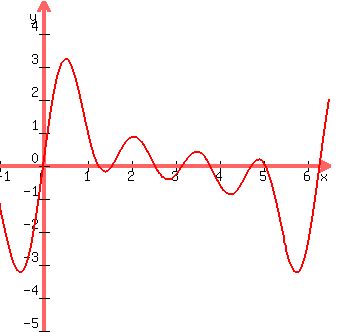.
sin(x) + sin(2x) + sin(3x) + sin(4x) = 0. (1)
Use the general formula of Trigonometry
 =
=  . (2)
You have
sin(x) + sin(4x) =
. (2)
You have
sin(x) + sin(4x) =  =
=  ,
sin(2x) + sin(3x) =
,
sin(2x) + sin(3x) =  =
=  .
Therefore, the left side of the original equation is
sin(x) + sin(2x) + sin(3x) + sin(4x) = 2*sin(2.5x)*cos(1.5x) + 2*sin(2.5x)*cos(0.5x) = 2*sin(2.5x)*(cos(1.5x) + cos(0.5x)).
Hence, the original equation is equivalent to
2*sin(2.5x)*(cos(1.5x) + cos(0.5x)) = 0, or, canceling the factor 2*sin(2.5x),
cos(1.5x) + cos(0.5x) = 0. (3)
Next, apply another general formula of Trigonometry
.
Therefore, the left side of the original equation is
sin(x) + sin(2x) + sin(3x) + sin(4x) = 2*sin(2.5x)*cos(1.5x) + 2*sin(2.5x)*cos(0.5x) = 2*sin(2.5x)*(cos(1.5x) + cos(0.5x)).
Hence, the original equation is equivalent to
2*sin(2.5x)*(cos(1.5x) + cos(0.5x)) = 0, or, canceling the factor 2*sin(2.5x),
cos(1.5x) + cos(0.5x) = 0. (3)
Next, apply another general formula of Trigonometry
 =
=  . (4)
Then the equation (3) becomes
. (4)
Then the equation (3) becomes
 = 0. (5)
Equation (5) deploys in two independent separate equations:
1. cos(x) = 0 ---> x =
= 0. (5)
Equation (5) deploys in two independent separate equations:
1. cos(x) = 0 ---> x =  , k = 0, +/-1, +/-2, . . .
2. cos(x/2) = 0 --->
, k = 0, +/-1, +/-2, . . .
2. cos(x/2) = 0 --->  =
=  , k = 0, +/-1, +/-2, . . . , or
x =
, k = 0, +/-1, +/-2, . . . , or
x =  =
=  , k = 0, +/-1, +/-2, . . .
From (1) and (2), in the given interval the original equation has the roots
, k = 0, +/-1, +/-2, . . .
From (1) and (2), in the given interval the original equation has the roots  ,
,  ,
,  , or 90°, 180°, 270°.
But these are not ALL the roots.
There is one more family of roots.
Do you remember I canceled the factor 2*sin(2.5x) ?
Of course, I must consider (and add to the solution set !) all the solutions of the equation
sin(2.5x) = 0.
They are 2.5x =
, or 90°, 180°, 270°.
But these are not ALL the roots.
There is one more family of roots.
Do you remember I canceled the factor 2*sin(2.5x) ?
Of course, I must consider (and add to the solution set !) all the solutions of the equation
sin(2.5x) = 0.
They are 2.5x =  , k = 0, +/-1, +/-2, . . .
or, which is the same,
, k = 0, +/-1, +/-2, . . .
or, which is the same,
 =
=  , k = 0, +/-1, +/-2, . . .
So, these additional solutions are x = 0,
, k = 0, +/-1, +/-2, . . .
So, these additional solutions are x = 0,  ,
,  ,
,  ,
,  , k = 0, +/-1, +/-2, . . .
The final answer is: There are two families of solutions.
One family is
, k = 0, +/-1, +/-2, . . .
The final answer is: There are two families of solutions.
One family is  ,
,  , and
, and  , k = 0, +/-1, +/-2, . . . , or 90°, 180° and 270°.
The other family is
, k = 0, +/-1, +/-2, . . . , or 90°, 180° and 270°.
The other family is  , k = 0, +/-1, +/-2, . . . , or 0°, 72°, 144°, 216°, 288°.
, k = 0, +/-1, +/-2, . . . , or 0°, 72°, 144°, 216°, 288°.
Solved.
CHECK
See the plot of the left side of the original equation
 Plot y = sin(x) + sin(2x) + sin(3x) + sin(4x)
Do you see 8 roots in the interval [
Plot y = sin(x) + sin(2x) + sin(3x) + sin(4x)
Do you see 8 roots in the interval [ ,
, ) ?
) ?